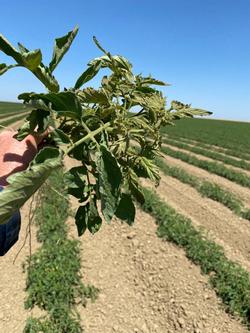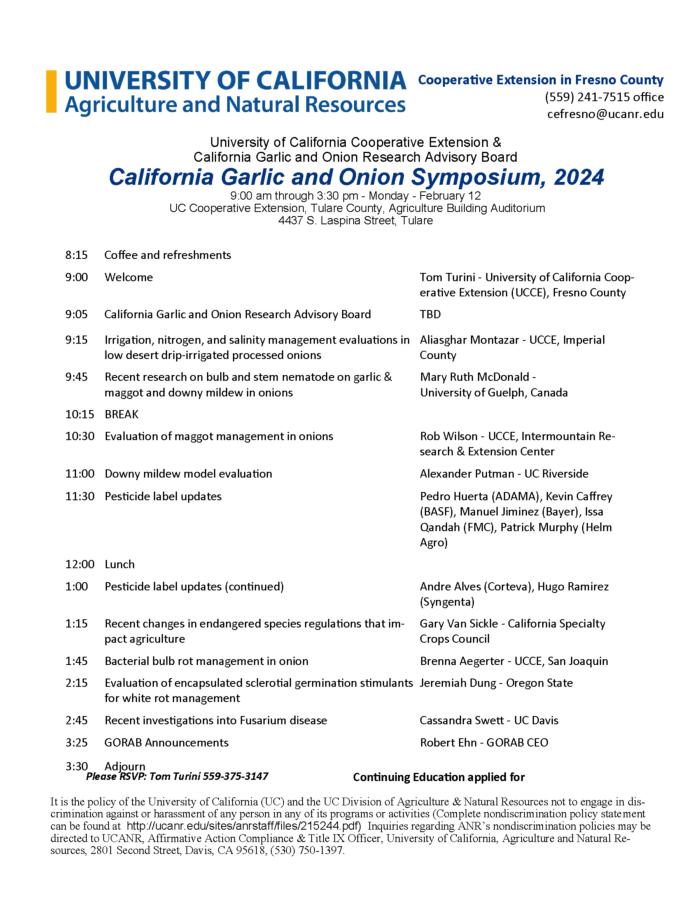Vegetable Crops
Vegetable crop production is an important component of agricultural production in Fresno County. The UCCE vegetable crops program addresses critical production issues in large scale vegetable crops, which includes processing and fresh market tomatoes, garlic, onions, and lettuce.
ucanr.edu
2023 Upcoming Events
About my Program
![tomatofield_21759[1] tomatofield_21759[1]](http://ucanr.edu/sites/Vegetable_Crops/files/77518display.jpg)
Vegetable crop production is an important component of agricultural production in Fresno County. The UCCE vegetable crops program addresses critical production issues in large scale vegetable crops, which includes processing and fresh market tomatoes, garlic, onions and lettuce.
The function of the vegetable crops Advisor is to address critical issues related to vegetable crop production through development and interpretation of science-based information. The focus of this program is on increasing efficiencies and sustainability of vegetable crop production through optimizing cultural practices, resource management and pest management.
Relative susceptibility of processing tomato varieties to Tomato spotted wilt virus in the Central San Joaquin Valley
Tomato spotted wilt virus present in Central California is capable of infecting and moving within plants with the Sw5 single gene resistance that is common in processing tomato varieties. Within Fresno, Kings and Merced counties, twenty-one commercial variety trials were evaluated for Tomato spotted wilt virus over three years and forty-six entries were compared. In addition, at each site, the ability of the virus present to break Sw5 resistance was tested. Lowest TSWV levels were observed in HM5522, BQ 400, SVTM1082, SV8011TM, N2428, HM4521, HM58801, BQ403, HM58841, H1428, HM58871, N6416, H5608, UG16609, HM5235 and SVTM9000, were among those expressing the lowest incidence of symptoms. Highest levels of TSWV expression were in HM 7885, N6420, HM8163, HM5369, N6366, AB0311, H1293, BOS0811, HM5511, H5508, DRI319, H2401, BQ273 and HM58811. In all areas tested, the TSWV present could break the resistance gene in tomato. With this information, growers and consultants can evaluate relative risk in consideration of the variety or varieties in the field in addition to other conditions that drive disease incidence and severity. See article for additional information.
Tomato spotted wilt virus April 2021

In some specific areas within Fresno County, which include Five Points, Huron and Cantua Creek, treatment for thrips is suggested based on presence of the virus and the stage of thrips population development.
Within parts of western Fresno County (Five Points), Tomato spotted wilt virus (TSWV) was initially detected in tomatoes in early April. By 16 Apr, areas within a few processing tomato fields had as much as 5% of the plants showing symptoms. In the area north of Huron and west of Five Points, the virus was detected in lettuce earlier in the season. The TSWV strain in the tomatoes and in the lettuce can move within and cause disease of tomato plants with the TSWV-resistance gene (Sw5). Therefore, the pathogen that poses a risk to tomato production is present in this area.
Based on the Western flower thrips predictive population development model peak egg hatch for generation two was on the 20 April and a substantial population of nymphs now exist. Peak for second generation adults is expected in early May. Thrips must feed on an infected plant as a wingless nymph to be capable of transmitting the virus as an adult. The winged, mobile adult can spread the virus within fields and to other fields. Therefore, an application of insecticides such as Radiant, Success or dimethoate to target the nymphs feeding on infected plants has the greatest potential of reducing spread of this virus. https://ucanr.edu/sites/TSWVfieldriskindex/Thrips_Population_Projections/Fresno/
April 2021 Beet leafhopper
With the onset of warmer weather and high winds, the vegetation in the foothills west of the San Joaquin Valley are likely to dry in the near future. This will result in the movement of Beet leafhoppers onto the valley floor. Most of this season, Beet leafhopper densities have been very low, but recently, an increase in population densities in the area south of Coalinga was noted by the CDFA Curly Top Control Board in a recent alert. The treatment of the area is now scheduled and an update from the Curly Top Control Board is planned to be released later this week.
Studies evaluating the impact of insecticide treatments on incidence of Beet curly top virus were conducted in 2015, 16 and 18. In these studies, Admire Pro applied through the drip and Verimark provided a significant reduction of disease incidence as compared to the untreated control under low to moderate pressure. These studies were conducted with the support of industry and California Tomato Research Institute. Note that this not a statement of current registration for your location and situation, all applicable current labels should be read before writing a recommendation.
University of California Agricultural Issues Center releases cost estimates for growing processing tomatoes
A new study on the costs and returns of producing processing tomatoes in Fresno County and the central San Joaquin Valley has been released by the UC ANR Agricultural Issues Center. Growers contemplating crops to grow may use the estimates to help decide whether to plant processing tomatoes.
The report estimates costs and returns and provides an overview of common production practices related to irrigation, fertility and pest management of processing tomatoes. In this report, some specifics are assumed, and calculations are based on a hypothetical well-managed farming operation described in detail.
Net profits are calculated relative to a range of yields and prices. Monthly cash costs, hourly equipment costs, operational annual equipment, investment and business overhead costs are included. The authors received input and reviews from UC ANR Cooperative Extension vegetable crops advisors and other agricultural associates.
The new study, “Sample Costs to Produce Processing Tomatoes in the San Joaquin Valley South, Fresno County – 2018,” can be downloaded for free from the UC Davis Department of Agricultural and Resource Economics website at http://coststudies.ucdavis.edu.

![lettuce08_21761[1] lettuce08_21761[1]](http://ucanr.edu/sites/Vegetable_Crops/files/77548display.jpg)